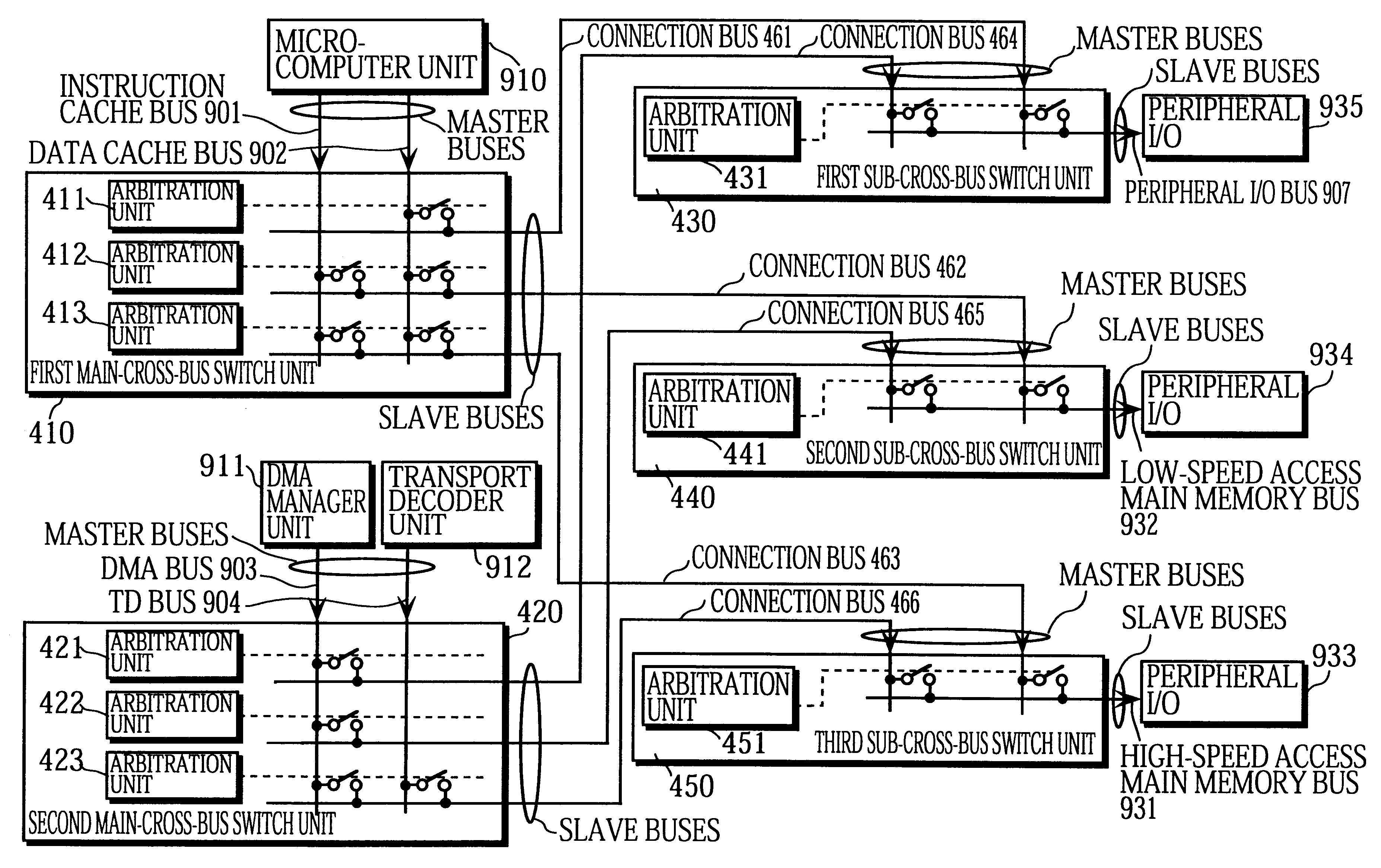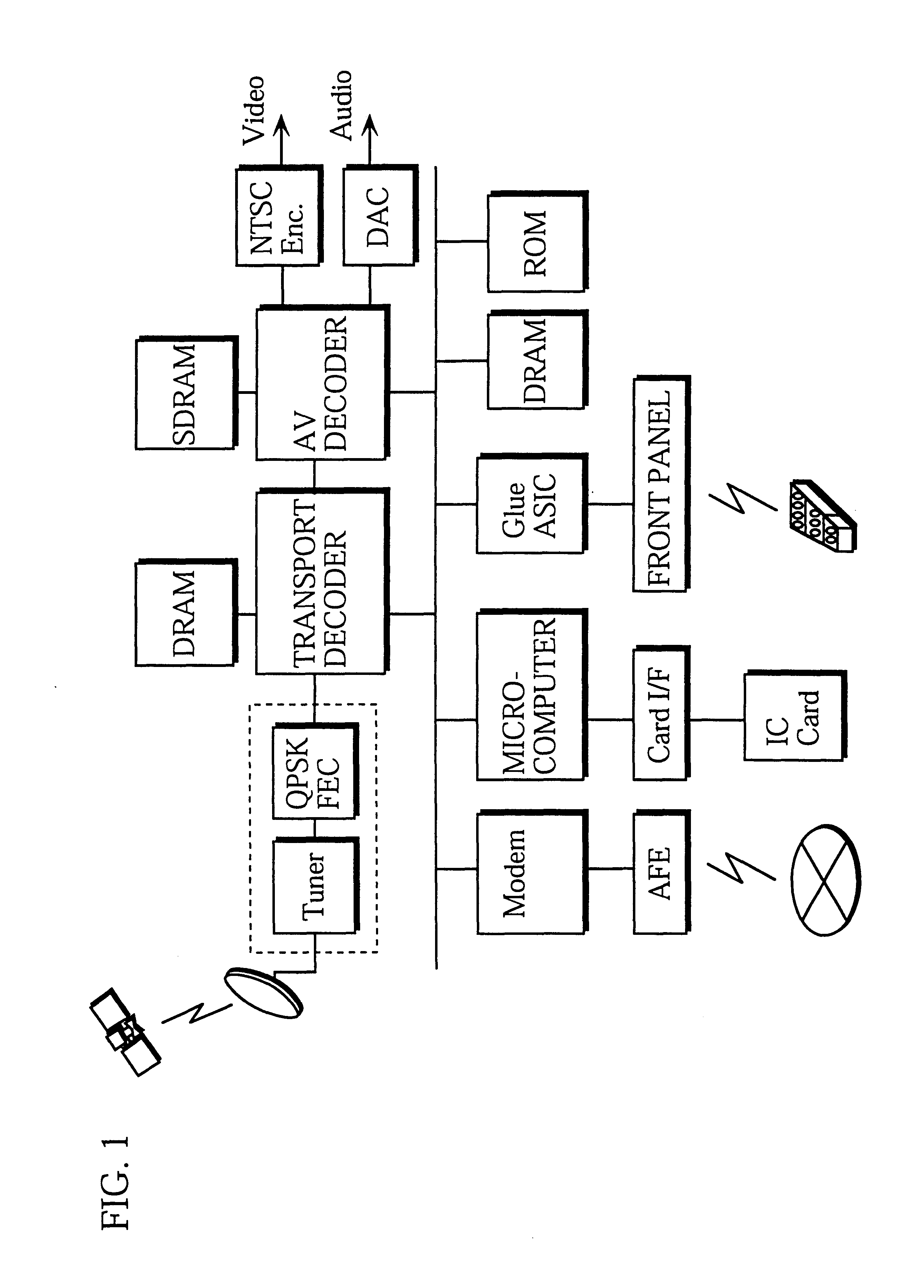System LSI and a cross-bus switch apparatus achieved in a plurality of circuits in which two or more pairs of a source apparatus and a destination apparatus are connected simultaneously and buses are wired without concentration
- Summary
- Abstract
- Description
- Claims
- Application Information
AI Technical Summary
Benefits of technology
Problems solved by technology
Method used
Image
Examples
embodiment 1
[0089]The cross-bus switch apparatus in Embodiment 1 of the present invention is characterized in that it has two circuits separated from a conventional circuit while the cross-bus switch apparatus has the same function as conventional techniques. More specifically, the TD bus and the other buses connected to the master bus side in the main-cross-bus switch unit are separated into different circuits; buses other than the TD bus are connected as master buses to the sub-cross-bus switch unit; and these cross-bus switch units are connected via a connection bus. The cross-bus switch apparatus of the present embodiment is expected to have excellent wiring efficiency and increased operating frequency.
[0090]
[0091]FIG. 7 shows the construction of the DBR system LSI using the cross-bus switch apparatus in Embodiment 1 of the present invention. The drawing also shows external devices or the like (two “SDRAM”s, a “ROM”, “Other devices”) connected to the DBR system LSI via ports.
[0092]The cross...
embodiment 2
[0129]The cross-bus switch apparatus in Embodiment 2 of the present invention uses an SDRAM as the high-speed access main memory in Embodiment 1. Also, the sub-cross bus switch unit of the present embodiment includes a slave bus corresponding to each bank of the SDRAM so that each bank can be connected to a master bus.
[0130]
[0131]FIG. 11 shows a simplified construction of the cross-bus switch apparatus in Embodiment 2 of the present invention. The drawing also shows units connected to the cross-bus switch apparatus.
[0132]The cross-bus switch apparatus in Embodiment 2 of the present invention includes a main-cross-bus switch unit 320, a sub-cross-bus switch unit 340, a connection bus 360, and an active bank transfer unit 380.
[0133]As shown in FIG. 11, the main-cross-bus switch unit 320 is connected to a set of master buses: the instruction cache bus 901, the data cache bus 902, and the DMA bus 903, and is connected to a set of slave buses: the peripheral I / O bus 907, the low-speed ac...
embodiment 3
[0146]The cross-bus switch apparatus in Embodiment 3 of the present invention is characterized in that source buses connected to the master bus side are grouped into two source bus groups on a substantially even basis, the two source bus groups are connected as master buses to two main-cross-bus switch units, and connection buses as many as destination buses to be connected are connected as slave buses to two main-cross-bus switch units. The same connection buses being slave buses for the two main-cross-bus switch units are connected as master buses to each sub-cross-bus switch unit corresponding to a destination bus, and the destination buses are connected to each sub-cross-bus switch unit as slave buses. This construction enables a circuit to be divided into a plurality of circuits without impairing the function, improving wiring efficiency and increasing operating frequency.
[0147]
[0148]FIG. 12 shows a simplified construction of the cross-bus switch apparatus in Embodiment 3 of th...
PUM
 Login to View More
Login to View More Abstract
Description
Claims
Application Information
 Login to View More
Login to View More - R&D
- Intellectual Property
- Life Sciences
- Materials
- Tech Scout
- Unparalleled Data Quality
- Higher Quality Content
- 60% Fewer Hallucinations
Browse by: Latest US Patents, China's latest patents, Technical Efficacy Thesaurus, Application Domain, Technology Topic, Popular Technical Reports.
© 2025 PatSnap. All rights reserved.Legal|Privacy policy|Modern Slavery Act Transparency Statement|Sitemap|About US| Contact US: help@patsnap.com



